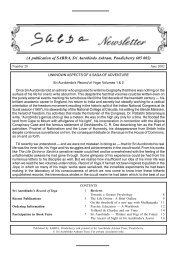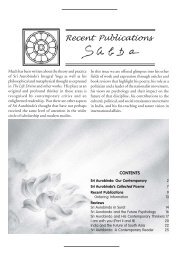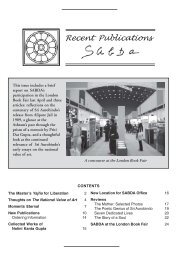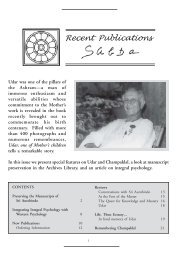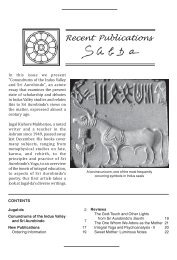November 2010 - Sabda - Sri Aurobindo Ashram
November 2010 - Sabda - Sri Aurobindo Ashram
November 2010 - Sabda - Sri Aurobindo Ashram
Create successful ePaper yourself
Turn your PDF publications into a flip-book with our unique Google optimized e-Paper software.
Other Authors<br />
Mother You said so...<br />
— Compiled and designed by Huta<br />
Publisher: The Havyavahana Trust, Pondicherry<br />
113 pp, ISBN 978-81-87372-24-0, Rs 200<br />
Size: 18x24 cm; Binding: Soft Cover<br />
This book records conversations which the Mother had<br />
with Huta from 1955 to 1973. Huta recorded the talks<br />
from memory and sent them the next day to the Mother<br />
for corrections. In these revealing talks, the Mother<br />
teaches Huta how to live the true inner life and constantly<br />
encourages her to overcome her problems and difficulties,<br />
to reject the influence of the adverse forces, and to open<br />
herself completely to the Divine. In addition, the Mother<br />
talks to her about the Future Painting. Also included are<br />
a few letters written by the Mother.<br />
See review on page 15<br />
Following in Their Footsteps<br />
Discovering <strong>Sri</strong> <strong>Aurobindo</strong>'s Life in England and The<br />
Mother's Life in Japan<br />
— Sunayana Panda<br />
Publisher: First Feature Ltd., London, UK<br />
126 pp, ISBN 978-0-9562923-1-5, Rs 160<br />
Size: 14x22 cm; Binding: Soft Cover<br />
This series of travel essays combines historical research,<br />
city walking tours, and textual references from the writings<br />
of <strong>Sri</strong> <strong>Aurobindo</strong> and the Mother to explore the various<br />
places in England and Japan where <strong>Sri</strong> <strong>Aurobindo</strong> and<br />
the Mother lived. The author muses on how these different<br />
physical environments and cultural influences may have<br />
contributed to the human aspects of their lives. Also<br />
included are essays on <strong>Sri</strong> <strong>Aurobindo</strong> the poet and the<br />
Mother as an artist, two areas of their lives in which their<br />
contact with England and Japan has played an important<br />
role. All essays but one have been previously published<br />
in journals. See review on page 17<br />
Golconde: The Introduction of Modernism in India<br />
— Pankaj Vir Gupta, Christine Mueller, Cyrus Samii<br />
Publisher: Urban Crayon Press, Washington, D.C., USA/<br />
New Delhi; 98 pp, ISBN 978-0-9795534-4-8, Rs 1600<br />
Size: 25x25 cm; Binding: Soft Cover<br />
Using a combination of historical narrative, early and<br />
recent photographs, architectural plans, and extracts from<br />
letters and diaries of those involved in the work, this<br />
book gives a history of the design and construction of<br />
Golconde, a dormitory for residents of the <strong>Sri</strong> <strong>Aurobindo</strong><br />
<strong>Ashram</strong>, and the first structure in India to use reinforced<br />
concrete throughout. The authors, a team of three<br />
contemporary architects, lay emphasis on its<br />
technologically innovative design, the precise<br />
craftsmanship in every detail, and the spirit of modernism<br />
with which the original architects conceived and carried<br />
out their design while addressing the harshness of the<br />
local climate, the scarcity of building materials, and a<br />
labour force untrained in modern construction methods.<br />
See review on page 12<br />
Uttara Yogi<br />
— Arup Mitra<br />
Publisher: Niyogi Books, New Delhi<br />
576 pp, ISBN 978-81-89738-55-6, Rs 495<br />
Size: 14x22 cm; Binding: Hard Cover<br />
This historical novel takes place in pre-independent India,<br />
at a time when efforts were being organised to throw off<br />
British rule. Through the narrative of the fictional<br />
character Harimohan Datta, who meets and befriends <strong>Sri</strong><br />
<strong>Aurobindo</strong>, the author recounts the story of <strong>Sri</strong><br />
<strong>Aurobindo</strong>’s life and his rise to prominence as a leader of<br />
the nationalist movement. Interwoven with the wellknown<br />
events and historical personalities of the day are<br />
varied characters who become involved in the adventures,<br />
betrayals, and tales of patriotism that move the story to<br />
its conclusion, the arrival of <strong>Sri</strong> <strong>Aurobindo</strong> in Pondicherry<br />
on 4 April 1910. See review on page 19<br />
Passage: An Educational Journey<br />
— Edited by Deepti Tewari<br />
Publisher: <strong>Sri</strong> <strong>Aurobindo</strong> International Institute of<br />
Educational Research, Auroville<br />
132 pp<br />
ISBN 978-81-903346-3-1, Rs 795<br />
Size: 22x22 cm<br />
Binding: Soft Cover<br />
This book presents in very broad<br />
strokes an experiment in free<br />
progress education from Last<br />
School in Auroville. The first part<br />
of the book, using many quotes<br />
from the Mother, summarises the aspiration at the base of<br />
Auroville's educational experiments. The second part,<br />
which is a photo essay and the main component of the<br />
book, presents Passage, the art installation created by<br />
four teenaged students of Last School. Part Three outlines<br />
some of the guidelines and methodologies used by their<br />
teachers. The book concludes with a few selections from<br />
<strong>Sri</strong> <strong>Aurobindo</strong> and the Mother, offered as lights on the<br />
way towards an education for the future.<br />
8



